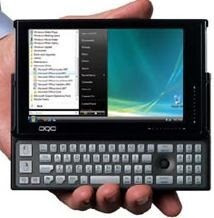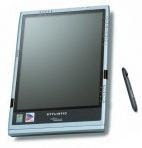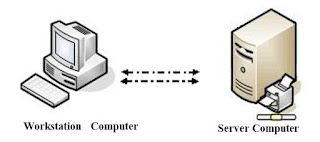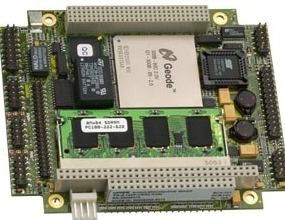Subnotebook
A subnotebook is a class of laptop which are smaller and lighter than typical notebooks. It is also called ‘ultraportable’. They generally are found to run full desktop operating systems such as Windows or Linux, rather than specialized software such as Windows CE, Palm OS or Internet Tablet OS.
Subnotebooks are smaller than laptops but larger than handheld computers. They often have smaller-sized screens, less than 14 inches and weigh less than typical laptops, usually being less than 2 kg (4.4 lbs). The savings in size and weight are usually achieved partly by omitting ports or having removable media or optical disc drives.
Palmtop
 |
| Palmtop Computer |
A palmtop is a hand-held microcomputer, i.e., small enough to be held in one’s hand. Although extremely convenient to carry, handheld computers have not replaced notebook computers because of their small keyboards and screens. The most popular palmtop computers are specifically designed to provide PIM (Personal Information Manager) functions, like a calendar, address book, etc.
Personal Digital Assistants (PDA)
.jpg) |
Personal Digital Assistant (PDA) |
A Personal Digital Assistant (PDA) is a hand-held microcomputer that trades off power for small size and greater portability. They are tightly integrated computers that often use flash memory instead of a hard drive for storage. These computers usually do not have keyboards but rely on touch-sensitive LCD screen for both output and input.
PDAs communicate with desktop computers and with each other either by cable connection, infrared (IR) beam or radio waves. It can function as a cellular phone, fax sender and personal organizer. PDAs are normally used to keep track of appointment calendars, to-do lists, address books and for taking notes.
Pocket PC
 |
| Pocket PC |
A Pocket PC is a hardware specification for a handheld-sized computer (PDA) that runs the Microsoft Windows Mobile operating system. It may have the capability to run an alternative operating system like NetBSD or Linux.
Pocket PCs can also be used with many other add-ons like GPS receivers, barcode readers, RFID readers and cameras.
Tablet PC
 |
| Tablet PC |
A Tablet PC is a notebook or slate-shaped mobile computer, first introduced by Pen computing in the early 90s with their PenGo Tablet Computer and popularized by Microsoft. Its touchscreen or graphics tablet/screen hybrid technology allows the user to operate the computer with a stylus or digital pen or a fingertip, instead of a keyboard or mouse. Tablet PCs are often used where normal notebooks are impractical or unwieldy or do not provide the needed functionality.
Ultra-Mobile PC
 |
Ultra-Mobile PC |
The Ultra-Mobile PC (UMPC) is a specification for a small form factor tablet PC. It was developed as a joint development exercise by Microsoft, Intel and Samsung, among others. Current UMPCs typically feature the Windows XP Tablet PC Edition 2005, Windows Vista Home Premium Edition or Linux operating system and low-voltage Intel Pentium or VIA C7-M processors in the 1 GHz range.
Home Theater PC
 |
| Home Theater PC |
A Home Theater PC (HTPC) is a convergence device that combines the functions of a personal computer and a digital video recorder. It is connected to a television or a television-sized computer display and is often used as a digital photo, music, video player, TV receiver and digital video recorder.
Home Theater PC
Home theater PCs are also referred to as media center systems or media servers. Because of the nature of the HTPC, higher than average capacities are required for HTPC units to allow storage of pictures, music, television shows, videos and other multimedia HTPC cases have a small LCD screen on the front where a user can view music/movie information.
Workstation/Server Computer
 |
Workstation/Server Computer |
A workstation is a high-end microcomputer designed for technical or scientific applications. Intended primarily to be used by one person at a time, they are commonly connected to a local area network and run multi-user operating systems. The term workstation has also been used to refer to a mainframe computer terminal or a PC connected to a network.
Historically, workstations had offered higher performance than personal computers, especially with respect to CPU and graphics, memory capacity and multitasking capability. They are optimized for the visualization and manipulation of different types of complex data such as 3D mechanical design, engineering simulation, animation and rendering of images, scientific calculations and mathematical plots.
The workstation class Personal Computer may have some of the following features:
(i) Support for ECC (Error Correction Code, i.e., a system of error control for data transmission) memory.
(ii) A larger number of memory sockets which use registered (buffered) modules.
(iii) Multiple processors.
(iv) Multiple displays.
(v) Run a “business” or “professional” operating system version.Server usually refers to a computer that is dedicated to providing a service to other computers over a network. A server application is a computer program that accepts connections in order to service requests by sending back responses. Servers usually have powerful processors, lots of memory and large hard drives. Examples of server applications include web servers, e-mail servers, database servers and file servers.
Client-Server Computer
 |
| Client-Server Computer |
Client–Server Computing or networking is a distributed application architecture that partitions tasks or work loads between service providers (servers) and service requesters (clients). Often clients and servers operate over a computer network on separate hardware. Classic client- server architecture requires one of the communication endpoints to act as a server, which is much harder to implement. A server machine is a high-performance host that is running one or more server programs which share its resources with clients. A client does not share any of its resources but requests a server’s content or service function. Clients therefore initiate communication sessions with servers which await (listen to) incoming requests.
The most basic type of client-server architecture employs only two types of hosts – clients and servers. This type of architecture is sometimes referred to as two-tier. It allows devices to share files and resources. The two tier architecture means that the client acts as one tier and application in combination with server acts as another tier.
In most cases, a client-server architecture enables the roles and responsibilities of a computing system to be distributed among several independent computers that are known to each other only through a network. This creates an additional advantage to this architecture: greater ease of maintenance.
For example, it is possible to replace, repair, upgrade or even relocate a server while its clients remain both unaware and unaffected by that change. All data is stored on the servers, which generally have far greater security controls than most clients.
As the number of simultaneous client requests to a given server increases, the server can become overloaded and this is the main disadvantage of client-server computer.
Embedded Computers
 |
| Embedded Computer |
Embedded computers are typically required to operate continuously without being reset or rebooted and once employed in their task the software usually cannot be modified. Embedded computers are very common. Embedded systems range from portable devices such as digital watches and MP4 players, to large stationary installations like traffic lights, factory controllers or the systems controlling nuclear power plants.
Wearable Computer
The latest trend in computer is Wearable Computer. A wearable computer is a computer that is subsumed into the personal space of the user, controlled by the user, and has both operational and interactional constancy, i.e., is always on and always accessible. They have been applied to areas such as behavioral modeling, health monitoring systems, information technologies and media development. Wearable computers are especially useful for applications that require computational support while the user’s hands, voice, eyes or attention are actively engaged with the physical environment.
One of the main features of a wearable computer is consistency. There is a constant interaction between the computer and user, i.e., there is no need to turn the device on or off. Another feature is the ability to multi-task. It is not necessary to stop what you are doing to use the device; it is augmented into all other actions. These devices can be incorporated by the user to act like a prosthetic. It can therefore be an extension of the user’s mind and/or body.





